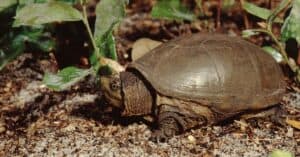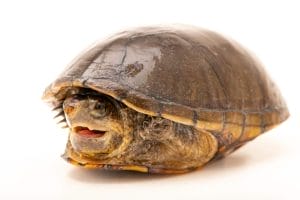Kinosternon vogti (Vallarta mud turtle)
Home > Turtle Database > Kinosternon vogti (Vallarta mud turtle)

The Vallarta mud turtle, Kinosternon vogti, is a small freshwater turtle endemic to Mexico. Known for its limited range and unique features, it thrives in specific habitats and faces conservation challenges due to its restricted distribution.
Native To These Regions
Jalisco (Mexico)Native Turtle Species Map – Find Turtles by Region
Scientific Classification
- Kingdom: Animalia
- Phylum: Chordata
- Class: Reptilia
- Order: Testudines
- Family: Kinosternidae
- Genus: Kinosternon
- Species: Kinosternon vogti
Common Names
Vallarta mud turtle, Vogt’s mud turtle
This Hilarious Turtle Book Might Know Your Pet Better Than You Do
Let’s be real—most turtle care guides feel like reading a textbook written by a sleep-deprived zookeeper.
This one’s not that.
Told from the snarky point of view of a grumpy, judgmental turtle, 21 Turtle Truths You’ll Never Read in a Care Guide is packed with sarcasm, sass, and surprisingly useful insights.
And hey—you don’t have to commit to the whole thing just yet.
Grab 2 free truths from the ebook and get a taste of what your turtle really thinks about your setup, your food choices, and that weird plastic palm tree.
It’s funny, it’s honest, and if you’ve ever owned a turtle who glares at you like you’re the problem—you’ll feel seen.
Identification
Description
The Vallarta mud turtle has a domed, oval carapace with a yellowish to olive-brown coloration, often featuring dark seams. Its plastron is hinged, allowing partial shell closure, which provides protection.
Sexual Dimorphism
Males are slightly smaller than females, with longer tails and concave plastrons to assist during mating. Females have shorter tails and flatter plastrons.
Check more turtles from the Kinosternon genus
Native Origin and Distribution
Geographical Range
This species is found exclusively in the Puerto Vallarta region of Jalisco, Mexico. Its range is highly localized, contributing to its ecological significance.
Preferred Habitat
The Vallarta mud turtle inhabits freshwater environments, including shallow ponds, marshes, and slow-moving rivers. It prefers areas with soft, muddy bottoms and dense vegetation.
Behavior
Feeding Habits
An omnivore, this turtle feeds on aquatic invertebrates, small fish, and plant material. It is opportunistic and adapts its diet based on seasonal availability.
Predators
Predators include birds of prey, larger mammals, and some aquatic predators like fish. Hatchlings are particularly vulnerable.
Reproduction
Breeding Season
Breeding occurs during the rainy season, typically between May and September.
Reproductive Method
Females lay small clutches of 2-4 eggs in sandy or soft soil near water sources. The eggs incubate for about 90-120 days, depending on environmental conditions.
Conservation
Extinction Status
Classified as Critically Endangered on the IUCN Red List due to its restricted range and habitat threats.
Threats
Habitat destruction from urbanization, agriculture, and pollution are primary threats. Climate change and illegal pet trade also contribute to its declining population.
Conservation Measures
Protected under Mexican wildlife laws, with efforts to conserve its wetland habitats and increase public awareness of its ecological importance.
Economic Importance
The Vallarta mud turtle contributes to local biodiversity and supports eco-tourism in the region, making it an essential species for conservation-focused tourism.
Interesting Facts
- This species was only described relatively recently, highlighting its cryptic nature.
- It has a hinged plastron, a feature shared by other members of the Kinosternidae family, allowing it to partially close its shell for defense.
- The turtle’s limited range makes it an indicator species for wetland health in the Vallarta region.

About Author
Muntaseer Rahman started keeping pet turtles back in 2013. He also owns the largest Turtle & Tortoise Facebook community in Bangladesh. These days he is mostly active on Facebook.














